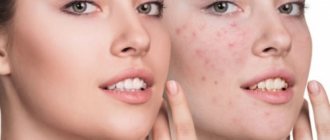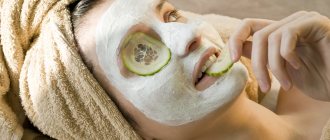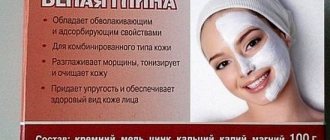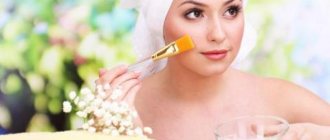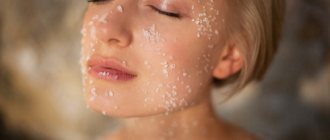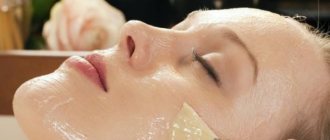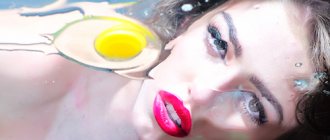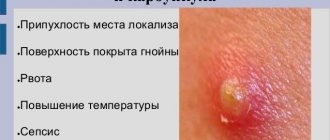Acne – behind the beautiful and mysterious name of the disease lies the most common acne or pimples. No one is immune from this; for various reasons, acne can appear in a person at any age, but teenagers react most acutely to this cosmetic defect. You need to start the fight for clear skin with proven recipes that were used to treat our ancestors when there were no antibiotics, but only natural products that, at home, have always saved teenagers from acne. Traditional medicine offers many recipes for acne. It is in your own kitchen that you will find the best products from which you can make the best acne mask.
What results can be achieved with masks?
Depending on the components of your home mask, you can achieve the following effect:
- elimination of subcutaneous acne;
- disinfection and drying of purulent rashes;
- decreased sebum production and skin oiliness;
- elimination of comedones (blackheads);
- whitening post-acne spots.
All this is truly possible with the help of ordinary products, without the use of “heavy artillery” in the form of pharmaceutical drugs. The main condition for a successful fight against acne is regular use and strict adherence to the dosage in each recipe.
Contraindications for acne masks
The products must be used taking into account contraindications. The use of masks is not recommended for:
- hypersensitivity to components;
- purulent skin lesions;
- the presence of diseases of internal organs;
- acne affecting an area of more than thirty percent of the body;
- elevated body temperature.
If contraindications are not observed, a painful reaction after application in the form of deterioration of the condition of the epidermis is possible.
Recommendations
For acne treatment to be effective, it is necessary to prepare the face before applying the composition, otherwise the effect is reduced to zero. Final procedures are also necessary.
- At home, you should definitely do a test to ensure there is no allergic reaction to the components of the mixture. The test is done on the inside of the elbow.
- Do not use honey preparations for acne in a teenager if you have previously had a reaction to bee products.
- For inflamed acne, peeling is strictly prohibited!
- Masks - films against comedones should be applied to a pre-steamed face. It is better to do this over a herbal decoction. After removing the film from the face, to narrow the pores, you should wash your face with a cold chamomile decoction or a chamomile ice cube.
Attention! You should not steam your face if you have inflamed and purulent acne - heat provokes increased suppuration and worsening of the condition.
To improve the effectiveness of treatment after procedures, it is recommended to use chamomile ice or chamomile decoction. It’s easy to prepare this remedy: brew 1 filter bag of chamomile with 200 ml of boiling water, cover with a lid and let cool. After this, pour the resulting broth into an ice tray and put it in the freezer compartment of the refrigerator. After the main procedure, wipe your face with chamomile ice, which will help narrow the pores, increase blood microcirculation due to temperature changes and accelerate the regeneration of epidermal cells.
How to make a face mask for acne
To do this, mix all the components in a small container and apply them to your face. Ingredients of natural origin must be used and the mixture should not be left on before applying to acne-prone areas unless otherwise specified in the formulation. Rules for preparing masks:
- first check for the presence of allergic reactions (the mask is applied to the wrist area);
- mandatory checking of expiration dates for components;
- mix until smooth or obtain a slurry consistency convenient for application;
- do not store remaining quantities of masks;
- Mix all components only in a clean container (preferably the dishes are porcelain or enamel).
Home remedies for acne have long been proven effective
Getting rid of subcutaneous acne
English mix with "Hercules"
To get an effective acne mask at home, you need to crush 3 tablets of acetylsalicylic acid (aspirin), add 10 ml of still water. Pour 10 ml of 0% kefir into 10 g of Hercules flakes ground in a blender, combine with the pulp from the tablets. Distribute the mixture over the skin, after 1/4 hour, wash and wipe your face with chamomile decoction.
Using the mixture for the face against acne is possible if you are not allergic to aspirin.
Honey + yeast
Add 40 ml of heated milk to 20 g of powdered yeast and leave to swell. Then combine the yeast with 15 g of honey and 15 g of starch. Bring the mixture to a pasty state, apply it to the skin, leave for 1/4 hour, then wash with running water.
Attention! A product with aspirin gives quick results, but the composition is used only once a month so as not to dry out the skin and not provoke the appearance of spider veins (rosacea).
Blue mix
Pour 20 g of cosmetic blue clay into 50 ml of 3.5% milk, add 10 ml of marigold tincture and 10 ml of fresh lemon juice. Combine the components and distribute the mixture over problem areas with acne. After 1/4 hour, wash off and use zinc ointment. This is the best acne mask based on blue clay.
For subcutaneous acne, masks should be alternated, then treatment usually takes about 1 month. When using one mask, the frequency should not exceed once every 12 days.
Acne on the chin: the reason is the wrong mask
To minimize the harm of a mask to facial skin, you need to choose this medical accessory correctly. Scientists have found that surgical masks provoke the most unwanted reactions in the form of exacerbation of acne and the appearance of new rashes. Most of them consist of several (3-4) layers of fabric, which are supplemented with filter sheets. They create an occlusive effect, do not allow air to pass through well, and do not allow moisture to evaporate.
It is recommended to switch to fabric masks made from cotton, polyester, and silk, which allow the skin to “breathe.” In addition, it must be changed every 4 hours. Reusable masks need to be washed after each use, while disposable masks must be thrown away after removal and cannot be reused.222
Getting rid of inflamed acne
3 tbsp. l. shaving foam should be combined with 10 ml of pharmaceutical hydrogen peroxide (3%) and 10 g of baking soda. The ingredients are thoroughly mixed, the mixture is applied to areas with acne, and after 1/4 hours, washed off with running water. The product has bactericidal properties, disinfecting purulent contents and promoting rapid healing of acne. This is the most effective acne mask at home.
"Africa"
Mix cosmetic clay (black), 10 ml of natural apple cider vinegar, 3 drops of tea tree essential oil, and a little mineral water. Distribute the product over areas with acne, rinse after 1/4 hour. This is the best homemade acne mask using black clay.
Quail egg mask
Quail eggs contain much more nutrients than chicken eggs, so masks based on them have a good nourishing and smoothing effect while successfully fighting acne. For one of the most effective acne masks, you will need 2 quail eggs, 10 g of rice flour, 4 drops of tea tree oil. Combine the components, distribute the composition over previously defatted skin. After 1/3 hour, wash with plain water, then with a cold chamomile decoction.
"Emergency" mask
An effective acne mask will dry out inflamed acne in just 1 day. You can use the product once every 14 days, otherwise you can dry out the skin. To prepare, combine 1 sachet of streptocide (2 g), 1 crushed tablet of chloramphenicol and 20 ml of pharmaceutical alcohol tincture of calendula. Mix the components, apply to the face for 1/3 hour, then rinse with plenty of water.
Preventing maskne: what to do to reduce the risk of rashes
The mask has become an integral part of our wardrobe. In accordance with the recommendations of WHO and the Ministry of Health of the Russian Federation, wearing it is mandatory in public places and transport where there are large crowds of people. It is impossible to refuse this accessory at the moment, so you need to try to reduce the risk of skin problems.
Here are the recommendations you should follow if you have to wear a mask often and for a long time:222
- Use delicate cleansers with a physiological pH level of 5.5.
- Deep cleanse problematic and oily skin no more than once a week. Clay masks, acid peels, and scrubs can only be used when acne is in remission. Enzyme peels with a more gentle effect are suitable for exfoliation.
- Don't forget about moisturizer. Even under a mask, the skin needs hydration. The day cream should not be too thick so as not to clog the pores.
- Use the need to wear a mask as an excuse to give your skin a break from daily makeup.
Your cosmetic bag should contain products containing:
- hyaluronic acid;
- squalane;
- fatty acid;
- ceramides;
- Niacinamide
These components are responsible for restoring the protective barrier on the skin and help strengthen the hydrolipid mantle.222
Reduce skin oiliness
"Limoncello"
Grate 1/4 fresh lemon (with peel), combine with 2 tsp. honey Distribute over oily areas of the skin, leave for 5-7 minutes, then rinse off with running water.
Protein mask
Beat 1 chicken protein with 10 g of boric acid (powder). Distribute over areas of skin with increased oil content, after a quarter of an hour, rinse with water. To complete the procedure, wash with chamomile infusion.
To speed up the treatment process, you can use a solution of apple cider vinegar instead of lotion to wipe the skin: 20 ml of 9% vinegar - 20 ml of boiled water.
The product is relevant for teenagers, since youthful skin is prone to excessive production of sebum, which subsequently clogs the pores, causing inflammation and suppuration.
Scrub mask for oily skin
Scrubs help the skin get rid of dead cells, leaving it smooth and glowing. As you know, scrubs are divided into chemical and mechanical. Chemical scrubs are made on the basis of lactic or fruit acid, mechanical scrubs contain particles (granules, crushed seeds or salt, etc.), which, by rubbing them into the skin, remove the top layer of dead epidermal cells. The scrub mask also has exfoliating properties, but at the same time it cares for the skin and lasts longer. We will talk about five types of exfoliating masks that are made from common products.
1. Strawberry exfoliation
If you purchased or picked this red berry from the garden beds, then do not regret one berry for your precious face. Just cut it in half and line the skin with strawberry slices. Keep the strawberries on your face for 10-15 minutes, periodically refreshing the layer, then wash.
Such a simple mask gives a truly magical effect: it whitens and refreshes the skin, tightens pores, and due to the fruit acid contained in strawberries, dead cells are gently exfoliated. By the way, it can be used not only for the face, but also for the neck and décolleté.
2. Mask-scrub based on cranberry and almond oil
The following recipe combines acid and mechanical exfoliation. To prepare a scrub mask, mash one tablespoon of cranberries, add a teaspoon of almond butter and brown sugar, and ½ tablespoon of oatmeal. Place the mixed mass on your face for 5-10 minutes, then rub the mixture over your skin with your hands and rinse with water. Cranberries, sugar and oatmeal will scrub it, and almond butter will soften it.
3. Mask-scrub based on strawberries
This mask is similar to the previous one. To prepare it, mix 1 tbsp. l. strawberry pulp (strawberries) with half tablespoons of honey and almond oil, respectively. Rub the mixture into the skin for two minutes, leave for another 5-7 minutes and wash your face.
4. “Gommage in Russian”
Fermented milk products are very useful for oily skin, and you can also make a kind of peeling ray from it. To do this, generously lubricate your face with kefir or yogurt, wait until the mixture is almost dry, then roll the remaining mask off the skin with wet fingers and rinse your face. The result will be smooth, hydrated and brightened skin.
5. "Beautiful skin"
Chop one tomato and carrot, squeeze the juice out of the mixture, add oatmeal until creamy. Place the “porridge” on your face, rub into the skin and leave for 20 minutes.
Recipes for removing comedones
To remove blackheads from problem areas, masks are used - films that are not washed off with water, but carefully rolled off the face in a whole layer (a complete list of the most effective recipes is here). When you remove the mask, it literally “pulls” impurities out of the pores, cleansing them of sebum, loose skin flakes and dust. Before applying a mask for acne and blackheads, the face is steamed over a herbal decoction or a hot compress is made to expand the pores.
Carbon film
Mash 1 tablet of activated carbon, add 20 g of edible gelatin to the powder. Pour 1 tbsp into the mixture. l. milk (3.5% fat) and heat in the microwave oven for 15-20 seconds until the mixture is completely dissolved in the milk. Distribute the composition over areas with comedones, excluding the eyes and eyebrows, with light tapping movements, let dry and apply a second layer. After 1/3 hour, carefully “roll” the film from the chin to the forehead, trying not to stretch the skin. Wash with an ice-cold chamomile infusion to tighten pores.
Sugar film
Beat the white of 1 chicken egg with 10 g of sugar. Apply the mixture in layers, drying each layer before applying the next. Dry the last layer, then actively pat the problem areas with your palms, driving the mixture into the pores. After 10 minutes, remove the composition.
Fruit film
Pour 10 g of edible gelatin into 150 ml of freshly squeezed fruit or vegetable juice (apple, peach, carrot, tomato) and place in the microwave until the gelatin is completely dissolved (for 15-20 seconds). Stir the mixture, cool, and then spread over the face. After half an hour, carefully “roll” the film from the face from the chin to the forehead.
Miracle - aloe
For this effective acne mask at home you will need 1 quail egg, 20 ml of lemon juice (citric acid will not work!), 20 ml of freshly squeezed aloe juice. Beat the ingredients, distribute the composition over problem areas of the skin in layers, drying each previous layer. After 1/3 hour, remove the mask.
Foods that cause acne
The first advice dermatologists give to people suffering from skin rashes is to reconsider their diet. Ignoring healthy foods and overindulging in junk food is a major factor in the development of acne.
To get rid of the rash, you need to give up only 6 types of foods:
- Coffee. This drink increases levels of cortisol, a stress hormone that thins and ages the skin.
- Sweets and baked goods. The ban includes not only confectionery products, but also sweet carbonated drinks and store-bought juices.
- A range of dairy products. Cheeses, ice cream, artificial yoghurts and curds with added dyes and flavor enhancers have a negative impact on the condition of the skin.
- Animal fats and fried heavy foods. Such food disrupts the normal functioning of the intestines, which causes problems with skin rashes.
- Fast food. Food in fast food establishments, crackers, chips, salted nuts are the first enemies of healthy skin.
- Alcohol. It increases skin oiliness and disrupts metabolic processes.
Whitening post-acne
Starch mix with tomato
Remove the skin from a medium-sized tomato and crush the pulp. Add 10 g of corn starch, combine the ingredients, achieving a homogeneous consistency. Spread the composition in a thick layer over the stained areas. After 1/3 hour, rinse off and wipe the skin with chamomile ice.
"Porcelain"
Mix 10 g of cosmetic clay (white) with 5 ml of lemon juice and 40 ml. mineral water without gas. Distribute over areas with pigmentation; no later than after 1/4 hour, the mask should be washed off.
“Citrus” fresh juice with parsley
Parsley is one of the best whitening agents. With its help you can get rid of almost any post-acne stain. To prepare fresh juice, you need to combine 10 ml of freshly squeezed parsley juice, 15 g of thin honey and 10 ml of freshly squeezed juice of any citrus. Distribute over face, wash after 1/3 hour, wipe face with chamomile ice.
Masks for tightening pores on oily skin
One of the characteristics of oily skin is enlarged pores, which, firstly, look unaesthetic, and secondly, they can become clogged with sebum and dust and subsequently lead to acne. Bad habits and food, as well as the use of powder, contribute to the expansion of pores. To reduce their size, at the end of the washing process, rinse your face with cold water and make pigment-reducing masks.
1. Egg white mask
This recipe is centuries old, but that doesn’t make it ineffective. Just mix a teaspoon of lemon juice with egg white and apply this cocktail to your face for a quarter of an hour, then rinse off.
2. Mask “Perfect Skin”
This mask is similar to the previous one, but unlike it, you also need to add a teaspoon of oatmeal to the mixture of protein and lemon.
3. Mask with added egg white
Dilute three teaspoons of oatmeal with water, add a little lemon juice and add the whipped egg white to the mixture. Leave for 0.5 hours.
4. Mask made from corn and oatmeal
Pour equal amounts of corn flour and oatmeal with hot water to form a paste. Leave the warm composition on your face for an hour. After the procedure, wipe your face with camphor alcohol dissolved in water.
5. Apple mask
This mask is perfect for sensitive oily skin. Combine yogurt, oatmeal, two drops of rosewood essential oil and a quarter of grated apple. Apply the resulting mask to your face for a quarter of an hour and rinse with water. The mask will help remove excess sebum and dead cells, as well as tighten pores.
Additional measures
Treatment of teenage acne should be comprehensive, otherwise no means will help, even the best acne masks. First, you should give up smoking and alcohol. McDonald's and other fast food outlets add transgenic fats and fast carbohydrates to the body, causing clogged pores and the formation of acne.
Under no circumstances should you squeeze out blackheads and subcutaneous pimples, as this will worsen the situation. The squeezed out purulent contents enter nearby pores, infecting them and increasing the area occupied by acne. The consequences of squeezed pimples are dark spots, scars and cicatrices that are subsequently very difficult to get rid of.
Acne is an unpleasant phenomenon that causes aesthetic dissatisfaction with one’s appearance, but they can and should be fought.
Sometimes it is enough to follow a simple diet that excludes too fatty, sweet and salty foods, increasing the amount of fruits and vegetables, so that the number of acne begins to decrease. And if you add daily facial skin care and wonderfully effective face masks for acne, then they simply don’t have the slightest chance.
Causes of acne
Acne in medical terminology is defined by the general concept of “acne”. The disease affects the pilosebaceous apparatus of the epidermis and is represented by visual defects. The main cause of occurrence is the inflammatory process at the point of the clogged pore, which manifests itself as a convex defect. The general association called “acne” includes the following types of acne:
- comedones;
- pustules;
- papules;
- nodular cystic;
- lightning fast.
They have visible differences, respectively:
- the former are open (in the form of black dots) and closed (white pimples);
- the second are formations that are convex relative to the dermis, when pressed, pain occurs;
- the third, unlike the second, have a white dot in the center through which the contents in the form of pus are released onto the surface;
- the fourth are represented by conglomerates of the third, they penetrate into the deep layers of the skin;
- with the fulminant variety, a large area is affected and severe pain is present, the disease causes changes in the leukocyte formula of the blood.
Factors contributing to the formation of acne on the body
- changes in the body at the hormonal level (adolescence, pregnancy, menstrual cycles) stimulate the active functioning of the sebaceous glands;
- linolenic acid – a reduced amount of this component leads to clogging of the pores of the epidermis;
- bacteria actively multiply in the ducts of the sebaceous glands;
- inflammatory process;
- external influence;
- unbalanced diet;
- predisposition of the dermis.
The nature of treatment is influenced by the degree of development of the disease:
- in the first case, comedones are present in the local area;
- on the second, comedones are present on the face and body;
- on the third there is a pronounced severity of the inflammatory process and rashes in the form of papules, pustules, comedones;
- with the fourth, there are pimples on the body that have penetrated into the deep layers of the skin (size more than five millimeters).
In the presence of the first two stages, therapy is symptomatic, the next two stages are systemic. Symptomatic treatment is carried out with special creams and masks; systemic - with the help of antibiotics and hormonal drugs. The relationship between factors contributing to the development of acne, its types and age is shown in the table.
Acne is a disease that affects the hair follicles and sebaceous glands.
Types of rashes and their causes
| Age | Factor | Type of rash | Method of treatment |
| Transition | Hormonal changes | Any of the above | Systemic/symptomatic – 3-4/1-2 stages, respectively |
| Adult | Contact with cosmetics, chemicals, etc. | Depends on the time of contact with the rash factor | Avoiding contact with the cause of the appearance in combination with anti-acne agents |
| Adult | Females, second part of the menstrual cycle | In the form of pustules, papules | No therapy is required, the rash disappears when hormonal levels stabilize |
| Adult | People with diseases of the genitourinary system or changes in the endocrine system | In the form of nodular-spherical pimples | Systemic type of therapy, treatment of the primary disease |
When taking steroid drugs for the purpose of gaining weight, rashes in the form of nodular-cystic spherical pimples are possible, which disappear with the end of taking steroids.
There is a relationship between the thickness of the skin and the predisposition to acne, so they:
- rarely present on dry type of epidermis;
- found on the forehead, chin when normal;
- on the T-section with combined;
- on the face, décolleté if oily.
To treat acne present in the first and second stages, the following measures should be taken:
- reducing fats and carbohydrates in the diet (increase – fruits, vegetables);
- increasing hygiene (face, hands);
- use of antiseptic care products (masks, creams).
Masks for the treatment of acne, when regularly applied to the area, prevent the entry of dirt, dust, bacteria and other factors that contribute to the inflammatory process. The product can be made with your own hands or purchased ready-made at a pharmacy chain or cosmetics store. The use of self-made masks is recommended:
- if the area affected by acne is no more than thirty percent of the body area;
- if there are no pathologies and diseases of internal organs;
- in the absence of elevated body temperature;
- with hormonal changes as the cause of the rash.
Masks against oily skin
1. From sauerkraut
Sauerkraut effectively absorbs the surface of the skin. Just spread a small layer of it on your face and wash after 15 minutes.
2. Revitalizing mask with spirulina
Dilute a few grams of powder with water until thick. Apply the resulting composition to the skin for 15-20 minutes.
3. Cucumber and yogurt
Grate half a cucumber and mix with a tablespoon of yogurt. Apply the mix for 20 minutes. on the skin.
4. From kefir and yeast
Dilute a pack of yeast with kefir. Apply the resulting paste onto your face for 20 minutes.
5. From yeast and juice
Mix a tablespoon of yeast with three tablespoons of fruit or berry juice. Apply the mixture for 20 minutes and rinse with water.
Rosacea
Rosacea (Figure 5) typically affects adults aged 30–50 years with fair skin. Typically, patients experience facial erythema and telangiectasia on the convex parts of the face (chin, cheeks, nose, forehead). The classic zone of rosacea distribution coincides with the area in contact with the mask when it is worn correctly. The chronic course and presence of telangiectasia usually helps to distinguish rosacea from perioral dermatitis. Rosacea can be caused or worsened by wearing a mask for long periods of time. Drug treatment includes topical agents such as 1% ivermectin cream once daily for mild cases. An oral tetracycline, such as moderate-release doxycycline 40 mg once daily for 8 to 12 weeks, can be added to the regimen for moderate to severe cases of the disease.
Figure 5. Rosacea
Skin care after the procedure
Proper skin care is the key to successful acne treatment. To increase the effectiveness of therapy, it is necessary:
- Toning. Immediately after the mask, the face is wiped with a toner, which normalizes the pH level of the skin. To do this, use products with natural ingredients - chamomile, nettle, lemon balm.
- Hydration. To prevent dehydration, the face is moisturized with a cream with glycerin and vitamins - tocopherol, retinol.
Daily facial treatment prevents the accumulation of sebum in the pores, inflammation of the hair follicles, and the formation of acne. Compliance with the rules of skin care not only eliminates rashes, but also prevents exacerbations of acne.
Allergic contact dermatitis
Allergic contact dermatitis (ACD) (Figure 1) is a delayed type IV hypersensitivity reaction to an external allergen that is much less common than ACD. This usually occurs after exposure to fixative chemicals such as formaldehyde and dibromodicyanobutane, but thiuram, a rubber accelerator found in the elastic straps of surgical masks, is also a recognized allergen. It has been reported that ACD on the face may be caused by nickel and cobalt forming a metal wire that is used to ensure that the mask fits more tightly to the face.
Figure 1. Allergic contact dermatitis
RCD and ACD may be clinically indistinguishable. Both usually present as localized dermatitis, but well-defined areas of inflammation and redness are more suggestive of ACD, while a more diffuse pattern is more often seen in RCD. Treatment is a short course of mild to moderate potency corticosteroids, such as 1% hydrocortisone ointment. Avoiding allergens prevents further episodes, and therefore identification of the causative agents is key. It can be carried out using a patch test, recommended for use in those cases and on those areas of the skin where well-demarcated areas are visible clinically, as well as in cases of severe disease.
